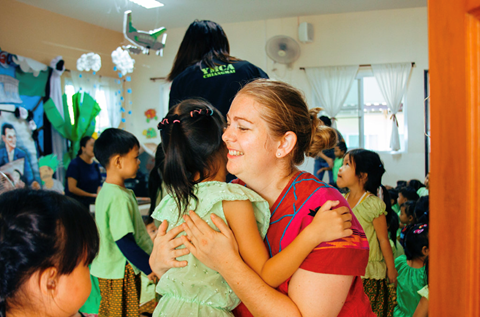Module 4.1 Daily Observation of Children
Learning Objectives
By the end of this module, you should be able to:
- Identify physical and behavioral signs of illness.
Daily Health Observations
Every day an informal, observation-based quick health check should be performed on every child (before the parent/caregiver leaves). Educators must use their knowledge about what is normal for a child to identify any concerns about the child’s well-being (but not as an attempt to formally diagnose illness). It is not a process that formally excludes children because of illness, but following up concerns noticed at a health check may find reasons to exclude children.
It can be challenging to spend a moment with every family upon arrival. Several families may arrive at the same time and parents are often anxious to get their child settled into the program so they can get to work on time. It should be kept in mind that this morning greeting routine has many benefits, other than just checking for signs of illness. It also helps educators better understand each child’s needs, sends the message to the child that they are welcome and safe and fosters better communication with families.
According to the Ontario Child Care Centre Licensing Manual (2019), “Licensees should encourage parents to share information about their child’s restless night, lack of appetite or other atypical behaviour. This information should be recorded in the daily written record and children who have demonstrated atypical behaviour should be monitored more closely for potential signs of ill health.” (Child Care Licensing Manual, 2019)

Conducting the Daily Health Observations
Educators need to use all their senses to check for signs of illness. This includes:
- Listening to what families tell you about how their child is feeling and what the child sounds like (hoarse voice, coughing, wheezing, etc.)
- Looking at the child from head to toe (with a quick scan) to see if the child looks flushed, pale, has a rash, has a runny nose or mucus in the eyes
- Feeling the child’s cheek or neck (as part of a greeting) for warmth or clamminess
- Smelling the child for unusual smelling breath or a bowel movement
Here are the signs to observe for:
- General mood and atypical behavior
- Fever (elevated temperature)
- Rashes or unusual spots, itching, swelling, and bruising
- Complaints of not feeling well (etc.)
- Reported illness in child or family members
36.(1) Each child care centre it operates and in each premises where it oversees the provision of home child care before the child begins to associate with other children in order to detect possible symptoms of ill health. (O. Reg. 137/15: GENERAL)
Fever
A fever is the body’s defense mechanism for fighting infection. It is one of many signs of illness. A child may be ill and not have a fever or, conversely, may have a fever but not be ill. Other factors that can raise body temperature include being dressed too warmly, strenuous play or a response to a recent vaccination. Contrary to widely held belief, teething does not cause a fever. It should be kept in mind that fever is not a reliable way to determine how ill a child is. “Observing a child’s behavior is much more important than taking a child’s temperature.” (Pimento & Kernested ,2015, p.180)
Conducting Observations Through the Day
The educator’s observations of each child upon arrival form a baseline. If a symptom is noted, educators can monitor the child during the day to see if the symptom gets better, worse or does not change. The baseline health assessment also helps the educator identify new symptoms that might appear during the day.
The Role of the Educator
“Work experience familiarizes educators with the more common childhood illnesses … Parents in the program, particularly those with infants or toddlers, often view educators as consultants on a range of topics, including their child’s health … However, giving out medical information is overstepping their professional boundaries. Diagnosing illnesses and offering medical consultation are the role of health professionals, not educators.” (Pimento & Kernested ,2015, p.185)
Important Things to Remember
- As a child’s educator you are the front line to gauge any signs and symptoms that may be concerning. With children regularly in your care, you can observe changes physically and in their behaviour.
- Daily health checks support a connection between educators and families.
Resources for Further Exploration
References
- Child Care Licensing Manual (2019). https://www.ontario.ca/page/child-care-centre-licensing-manual
- O.Reg. 137/15: GENERAL. https://www.ontario.ca/laws/regulation/150137#BK46
- Pimento, B., Kernested, D. (2015). Healthy Foundations in Early Childhood Settings, Fifth Edition. Toronto: Nelson.

